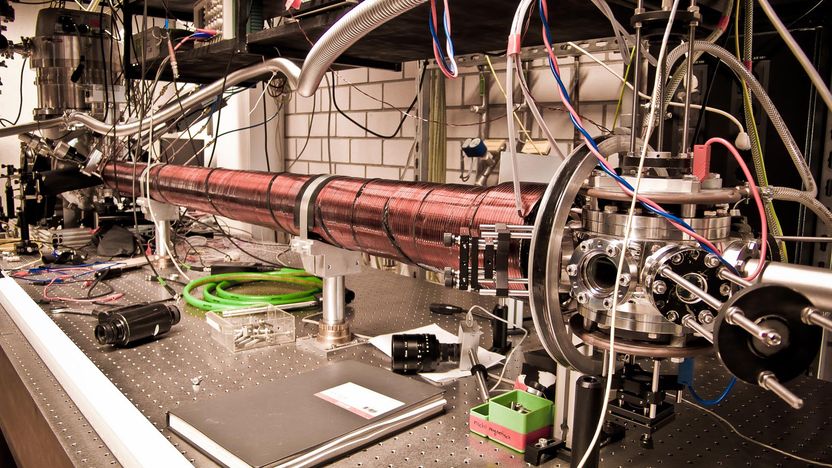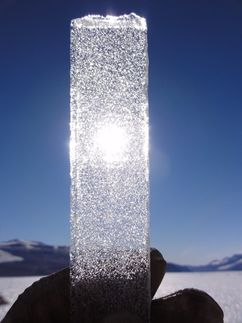Help in the Search for the Needle in the Haystack
Physicists render usable method for detecting extremely rare inert gas isotopes for water dating
In the earth and environmental sciences, radioactive isotopes, atom variants that decay over time, play a major role in age determination. A radioactive isotope of the inert gas argon (39Ar), for example, is used to determine the age of water or ice. Such isotopes are extremely rare, however – only a single 39Ar isotope occurs in a thousand trillion argon atoms. Hence researchers’ attempts to isolate and detect such atoms remain the proverbial search for the needle in a haystack. Physicists at Heidelberg University have now succeeded in rendering usable an experimental method developed in basic research for ground water dating using 39Ar. According to the researchers, these results open up new perspectives in investigating glacial ice and deep-water circulation in the ocean. The results of the research were published in the journal “Geophysical Research Letters”.

Picture of the apparatus for 39Ar-ATTA
© C. Kaup
The most well-known example of age determination using radioactive isotopes is radiocarbon dating, which is used for dating organic material in the environment as well as for archaeological finds. Similarly, the abundance of radioactive isotopes of the inert gases argon and krypton can be used to determine when groundwater, deep ocean water or glacial ice formed. To detect and isolate the rare atoms from water, innovative experimental methods are used that were developed and perfected in the course of basic research on quantum mechanical systems. Scientists at the Kirchhoff Institute for Physics and the Institute of Environmental Physics at Heidelberg University were now able for the first time to use the method known as Atom Trap Trace Analysis (ATTA) to date groundwater using 39Ar.
Members of the environmental physics working group headed by Prof. Dr. Werner Aeschbach-Hertig first isolated pure argon from over 1,000 litres of groundwater. Using a specially developed ATTA apparatus, the team of Prof. Dr. Markus Oberthaler at the Kirchhoff Institute “trapped” the 39Ar atoms and detected each one. The scientists underscore that this achievement, which culminates years of joint development work, now opens the door to a multitude of new applications for 39Ar dating. “The project is an outstanding example of how methods developed in basic research of quantum mechanical properties can open up new application horizons,” explains Prof. Oberthaler. The study’s primary author, Dr. Florian Ritterbusch, is convinced that the measurement method can be made even better: “In principle, a litre of water should be enough for a measurement.” These advances should soon make possible the first measurements of 39Ar in glacial ice in the Alps. The researchers also believe that 39Ar has the greatest potential in the study of deep water circulation in the ocean. “To do that we have to be able to take sufficiently accurate measurements from samples of less than ten litres of water,” says Prof. Aeschbach-Hertig.
The pioneers of the new method from the Argonne National Laboratory in the U.S. organised a special ATTA workshop in Chicago in 2012 to discuss possible applications of krypton isotopes in the earth and environmental sciences. The Heidelberg ATTA collaboration is organising another such gathering to be held in March 2015. The progress made in Heidelberg in working with 39Ar once again considerably broadened the range of applications, as the researchers emphasise. “The new method also represents an innovative expansion of the strong competence in isotope and dating methods that is present in Heidelberg and concentrated at the Heidelberg Center for the Environment,” says Prof. Aeschbach-Hertig.
Original publication
Other news from the department science

Get the analytics and lab tech industry in your inbox
By submitting this form you agree that LUMITOS AG will send you the newsletter(s) selected above by email. Your data will not be passed on to third parties. Your data will be stored and processed in accordance with our data protection regulations. LUMITOS may contact you by email for the purpose of advertising or market and opinion surveys. You can revoke your consent at any time without giving reasons to LUMITOS AG, Ernst-Augustin-Str. 2, 12489 Berlin, Germany or by e-mail at revoke@lumitos.com with effect for the future. In addition, each email contains a link to unsubscribe from the corresponding newsletter.

























































